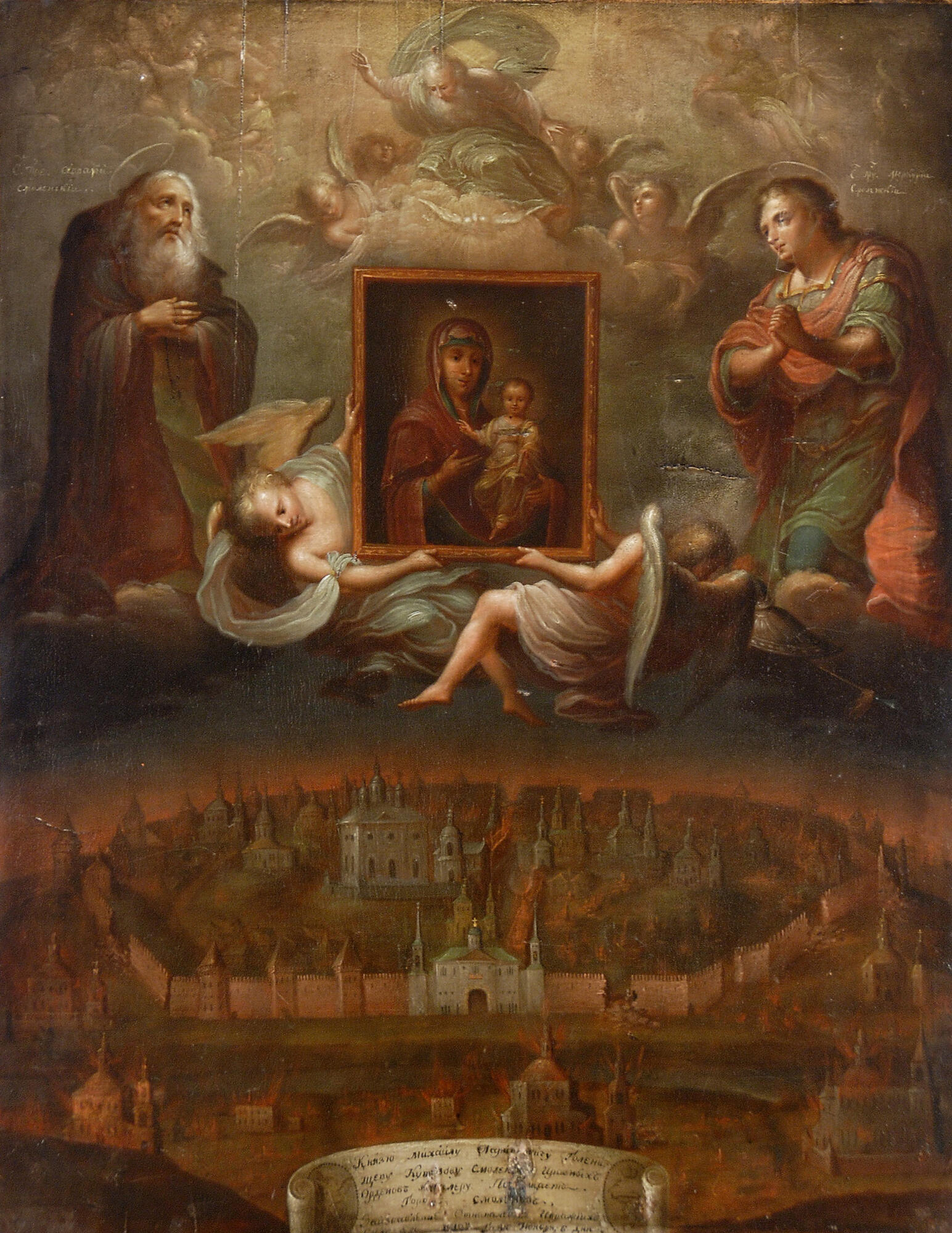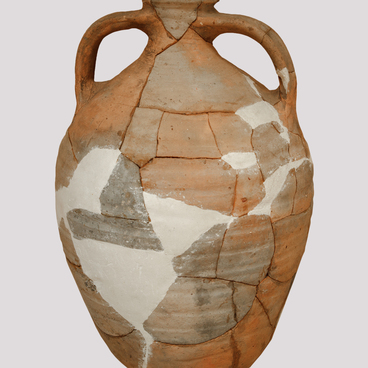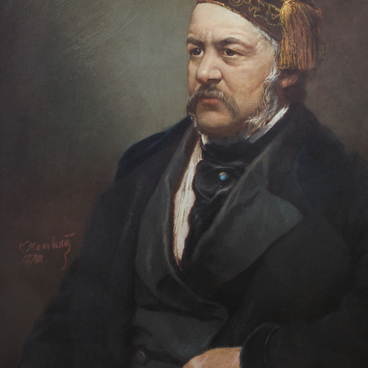According to legend, the icon was commissioned by the Smolensk residents in late 1812 — early 1813. They wanted to present it to Field Marshal Prince M.I. Golenishchev-Kutuzov-Smolensky as a token of gratitude for the liberation of Smolensk from the Napoleonic invasion. The icon was painted by a Smolensk artist. In the center of the icon is a detailed panorama of Smolensk, surrounded by a fortress wall. The city is on fire. This reflects a real historical event — the fire of Smolensk on August 5, 1812 during the storming of the city by the Napoleonic army. In the upper part of the icon there is an image of the Smolensk Mother of God Hodegetria, supported by angels.
Above the Mother of God is the blessing god Sabaoth and the holy spirit in the form of a dove. On both sides of the Hodegetria are the patron saints of Smolensk, the Saint Abraham and the Martyr Mercury of Smolensk. In the lower part of the icon there is a cartouche in the form of an unfolded scroll with the text of dedication: ‘This is dedicated by the city of Smolensk to Prince Mikhail Larionovich Golenishchev Kutuzov of Smolensk and the knight of various orders for the rescue from Napoleon and his enemy forces. 6 November 1812’.
On both sides of the cartouche there are two emblems of Smolensk: the old one, with the image of the Archangel Michael, and the new one, with a cannon and the bird Gamayun sitting on it. On the reverse side of the icon there is an inscription from the 1st quarter of the 19th century: ‘From the eagerness of the Smolensk merchants and philistines.’ However, the Smolensk citizens failed to present the icon to M.I.Kutuzov. During his overseas campaigns, the field marshal died on April 16, 1813 in the city of Bunzlau in Silesia, and the icon was placed in eternal storage in the Assumption Cathedral. However, already in July 1815 it was presented to the daughter of the commander D. M. Opochinina, who visited Smolensk on her way. Former mayor Kozma Verzin wished to paint the same icon at his own expense, so that it would forever remain in Smolensk. With a certain degree of probability, it can be argued that the icon kept in the Smolensk Museum is the very same copy from the icon presented to Kutuzov’s daughter. The original is now kept in the State Hermitage in St. Petersburg.
Above the Mother of God is the blessing god Sabaoth and the holy spirit in the form of a dove. On both sides of the Hodegetria are the patron saints of Smolensk, the Saint Abraham and the Martyr Mercury of Smolensk. In the lower part of the icon there is a cartouche in the form of an unfolded scroll with the text of dedication: ‘This is dedicated by the city of Smolensk to Prince Mikhail Larionovich Golenishchev Kutuzov of Smolensk and the knight of various orders for the rescue from Napoleon and his enemy forces. 6 November 1812’.
On both sides of the cartouche there are two emblems of Smolensk: the old one, with the image of the Archangel Michael, and the new one, with a cannon and the bird Gamayun sitting on it. On the reverse side of the icon there is an inscription from the 1st quarter of the 19th century: ‘From the eagerness of the Smolensk merchants and philistines.’ However, the Smolensk citizens failed to present the icon to M.I.Kutuzov. During his overseas campaigns, the field marshal died on April 16, 1813 in the city of Bunzlau in Silesia, and the icon was placed in eternal storage in the Assumption Cathedral. However, already in July 1815 it was presented to the daughter of the commander D. M. Opochinina, who visited Smolensk on her way. Former mayor Kozma Verzin wished to paint the same icon at his own expense, so that it would forever remain in Smolensk. With a certain degree of probability, it can be argued that the icon kept in the Smolensk Museum is the very same copy from the icon presented to Kutuzov’s daughter. The original is now kept in the State Hermitage in St. Petersburg.



